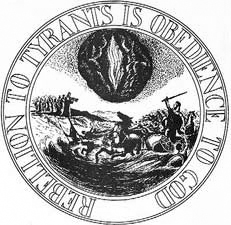National Symbols
Now that the patriots won the Revolution, ditched their first government structure, and wrote a new one while wining and dining at George Washington’s expense, the United States must become “a nation” in our class. I asked my students to name all the ways they “know” they’re in the United States each day. One mentioned the currency, which not only says United States on it, but has the image of a president or famous American. One mentioned American flags outside of buildings and homes. Another mentioned the national anthem, and we all had a moment of silence for Whitney Houston. We even discussed how if they were arrested (which I encouraged them not to be) that they had rights that were codified in a legal document – the Constitution – that they may not have elsewhere.
 |
| http://greatseal.com/committees/firstcomm/ |
The point of the discussion was this: nation’s create their identities through symbols and as the United States became a new nation in the 1770s and 1780s, it needed to create a whole new batch of national symbols. I’m trying to bring them into the concept of nations as “imagined politicalcommunities,” as Benedict Anderson so nicely put it. But I also want to show them that these national symbols shift and change as the community does. One place I begin is with the proposed seal from 1776 for the new nation. Anyone who studies US religious history knows about the seal – Thomas Jefferson, Benjamin Franklin, and John Adams suggested a seal with the image of Moses leading the Israelites out of their bondage in Egypt to the Promised Land of freedom and liberty. But what is often forgotten was that Jefferson also wanted on the obverse of the seal the likenesses of Hengist and Horsa, the two brothers who supposedly led the first Anglo-Saxon settlers in Britain. (other ideas included an image of Hercules). The seal was never adopted, but we see a number of fascinating topics in its discussion. First, it was a conscious and deliberate discussion of nationalism building – of creating a symbol (or symbols) that would demonstrate to Americans that they were Americans. Second, it showed that national symbol making is complicated work. Imagining the United States as a land of freedom from slavery cut two ways; it inspired resistance to the British, but it also could put ideas into the heads of African American slaves that Jefferson didn’t want. Third, it raised the issues of what freedom meant: religiously and racially. Freedom was understood as from God (hence Exodus), but also from Anglo-Saxons (hence Hengist and Horsa). So there would be some measure of religious freedom for whites, but people of color would be often ignored or marginalized in this new approach to liberty.
I wonder what other images of nationalism building folks use or discuss. I am also wondering if others deal with this issue of the making of an American identity.
And finally, and maybe Kevin could talk more about this, the difference between “E Pluribus Unum” and “Under God” as national mottos.
And even more finally, maybe my students will look closely at the image from Federalists mocking Democratic-Republicans in Major Problems, and maybe they’ll pay attention to which founding leaders supported states’ powers, manufacturing, and the strength of the Supreme Court. Those topics may be on a quiz … oh, and go SDSU softball! Three big games this weekend.



I actually have an essay question that I run around mid-semester for my students. In it, I ask them when the Revolution actually ended and when the United States became a united nation. I’m keying off of the end of the War of 1812, where we start to get other symbols, like the “Star-Spangled Banner” and Uncle Sam. They have to evaluate whether a better answer for when the US became a united nation would be the end of the Revolution, the drawing up of the Constitution, or the end of the War of 1812.
I even have some students who reject all of those options in favor of the post-Civil War period. A few others even say that they don’t think we’ve ever become a truly united nation at all.
Anyway, certainly an interesting topic.
Hey Scott, the question of nationalism is always fun because there are so many ways to approach it. I always love getting to the “American Anti-Slavery Society” and discuss how it only represented a small group of people from a particular region … so why did they name it “American.” I also like to factor in the making of an “American” English dictionary and other uses of the word “American” in the 1830s and 1840s. Of course, we get 2 “Americas” in the 1860s with the CSA and the USA.
One of my points is that national symbols are like nationalisms – constantly being negotiated, redefined, challenged, turned on their heads.
I also like to pull from the Chicago School’s studies on cities and race. I especially like John Dollard’s 1937 “Caste and Class in a Southern Town” and Gunnar Myrdal’s 1944 “An American Dilemma” to broaden notions of groups and regional belonging. The second text in particular offers symbols that generally resonate with students (e.g. the American “front porch,” or the lunch counter – sites where interviews took place in the study, and sites that are seemingly abundant in a variety of art forms…literature, films, etc.) but these sorts of studies also simultaneously articulate distinct regionalities and other-ness along with an underlying notion of American-ness, and definitely challenge the monolith (or at least the singularity) of American “nationalism.”